It can be inconvenient when your favorite restaurant in the world is on another continent. But we don’t really get to choose these things, do we? Your favorite thing is your favorite thing because it elicits some primordial, visceral response in you. So as much as there are hundreds of incredible restaurants within a subway ride of our apartment in New York City, none of them will ever, for me, beat the magic of Venice’s Osteria Al Portego.
And that’s ok. Because, miraculously, I’ve lived in New York City for over 23 years now, and despite all my best efforts, when I enter my most frequented NYC restaurants, in none of them does the staff immediately recognize me and welcome me back. When I walk through the doors of Al Portego, on the other hand, no matter how much time has passed since my last visit, I’m immediately greeted with a smile, a warm “Ciao!,” and a glass of prosecco. And when the bill is delivered at the end, the actual price is always crossed out and replaced with a wonderful mega-sconto, the “mega-discount” typically reserved only for Venetians.
The story of how Tibi and I became regulars at a Venetian osteria is somewhat irregular, to say the least.
Tibi and I went on our first date on Friday, January 16, 2009. During our second date, a couple days later, we started talking about our love of travel, and Tibi asked me about my favorite city I’d ever visited. Without hesitation, I responded, “Venice!”
I had visited Venice for the first time about seven months prior to this conversation. After the transformative experience of my first solo trip to Europe in early 2007, I spent the following year-and-a-half saving all my money for another solo trip—this time to Italy. My friend Brittany’s family was renting a villa in a small Tuscan village where I would stay for a few days in the middle of the trip. On either end, I would travel by train and stay in hostels as I visited the Italian cities everyone raved about: Milan, Cinque Terre, Florence, Rome, and Venice. In planning out my trip, I asked everyone I knew who had been to Italy for suggestions. In particular, I asked how long they thought I should stay in each place as I tried to cobble together an itinerary that would allow me to suck as much marrow as possible out of each location. Again and again, friends and colleagues told me only to reserve a day or two for Venice. They all said it was overcrowded and overrated. On top of these recommendations, I had recently joined the hoards of others who had read Elizabeth Gilbert’s Eat, Pray, Love. In the book, Gilbert absolutely laments her time in Venice, describing it as one of the most depressing places she’s seen. Not being one to buck a trend, I followed the advice I received and planned to spend two measly nights there.
I regretted this decision the minute my train arrived in Venice. I stepped out of the train station to catch my first view of the Grand Canal and the green, domed roof of Chiesa di San Simeon Piccolo across it, and I fell immediately and irrevocably in love. For the next day and a half—and most especially at night, as I wandered through the silent city, watching the light ripple in the canals—I came down with a chronic case of Stendhal syndrome. Even while I was still there, all I could think was how much I wanted to come back. But not just come back…to come back with someone I loved.
So when Tibi asked me about my favorite place I had visited on that second date in 2009, I told him all of this. And the next day, without asking or telling me, Tibi bought the two of us plane tickets for Venice for a month and a half later. I can’t remember when he told me that we were going. For awhile, he just asked me to block four days in my calendar in early March. But eventually he had to actually tell me about the trip, and after getting over a plethora of doubt—“Isn’t it crazy to be traveling to Venice with some guy I just met six weeks ago?”—I gave into the glamor of it all and began planning.
My most trusted resource for finding restaurants at that point was the New York Times’ Travel Section. And just about a week before our trip, the NY Times’ writer Matt Gross, who wrote a blog called The Frugal Traveler, wrote an article about experiencing Venice on the cheap, in which he mentioned discovering a delicious and inexpensive osteria that is “tough to find unless you wander long enough…or are directed there.” This sounded absolutely dreamy to me, so I added it to our list of places to go during our long weekend together.
Our first evening in Venice, we went in search of a restaurant where I had eaten the year prior. After following some vague memories I had about its location, we found it. And it was…fine. Now, after many trips to Venice, I know that it was actually a tourist trap with only mediocre Venetian food that would pale in comparison to the real stuff, as I would learn the next night, when we went to Al Portego.
As this was an age before we all had access to Google Maps on our cellphones, we had nothing but an address and a few suggestions from the hotel concierge to help us find this restaurant. Addresses in Venice are worthless for anything other than mailing a letter. For one thing, they do not include street names, which makes sense when you learn that no one in Venice can really agree on what a given street is called. The street names in Venice are painted on to the walls of buildings as stenciled, black letters against a white, rectangular background. These painted street signs are known as nizioleti, from the Venetian nisioeti, meaning “small sheets.” It is not at all rare to encounter a street or a bridge in Venice with multiple names, both of which will be marked on the nizioleto. For instance, the name of one bridge in Venice is either the Bridge of Christ or the Bridge of the Silk Dyer. It just depends of who you ask. And, in reality, most Venetians won’t know any of these names at all, preferring instead to refer to streets as “the one right after the gelateria” or “the street across from the flower shop.”
Addresses in Venice, then, do not include a street name, merely a number and the name of one of the six neighborhoods—or sestiere—of Venice. The street numbers are equally unhelpful. Each building in Venice has a unique number, and there is no real logic that I have been able to determine to which buildings have which number. So the only thing you can really ascertain from an address is the neighborhood in which the place is located. For the rest, you just have to ask around. (This is different nowadays, as Google Maps has gotten much better at denoting the location of Venetian addresses…though it still gets it wrong plenty of times.)
After many wrong turns and fumbling conversations with locals, we finally found Osteria Al Portego, and, upon entering, we were immediately enamored with the place. A high, L-shaped bar greets you, its glass cases filled with mouthwatering cichetti—small bites of Venetian goodies that you often eat with pre-dinner drinks. Beyond the bar is a tiny dining room with six wooden tables. Copper pots and pans hang from the ceiling, and dark, warm wood paneling embraces you.
You’re never handed a menu at Al Portego. Because the menu changes daily, it only exists on a chalkboard that covers an entire wall of the dining area. There, diners find four columns of food listing today’s antipasti, primi, secondi, and dolci. Everything is written in Italian exclusively. These days, there is always at least one person on staff who speaks English and will perhaps be patient enough to translate things for you. During our first visit, it was an Italian-only affair.
Our server was a carefree young woman with long, dirty-blond hair who got progressively drunker as the night went on. At places like Al Portego, it feels particularly pretentious to order bottled wine when everyone else in the joint is drinking the slightly chilled red pulled from the tap and served in beautiful, custom-made ceramic carafes that feature a handpainted rendition of the ancient well from the exterior courtyard. The wine is always the same: a bright, fruity, perfectly acidic cabernet that miraculously goes with everything, including the seafood. Despite having had so many amazing meals at Al Portego at this point, I still remember that first meal, more or less. It involved pillow-soft gnochetti, the traditional Venetian dish of cuttlefish cooked in its own ink, and a perfect panna cotta with a sauce of frutti di bosco. We luxuriated in the meal over several hours, ultimately closing the place down. When in our drunken bliss we left a hefty tip for our waitress, who at this point was singing and dancing merrily as she wiped down the other tables, she picked up the 20 euro note and flashed it in the face of all her colleagues to show it off.
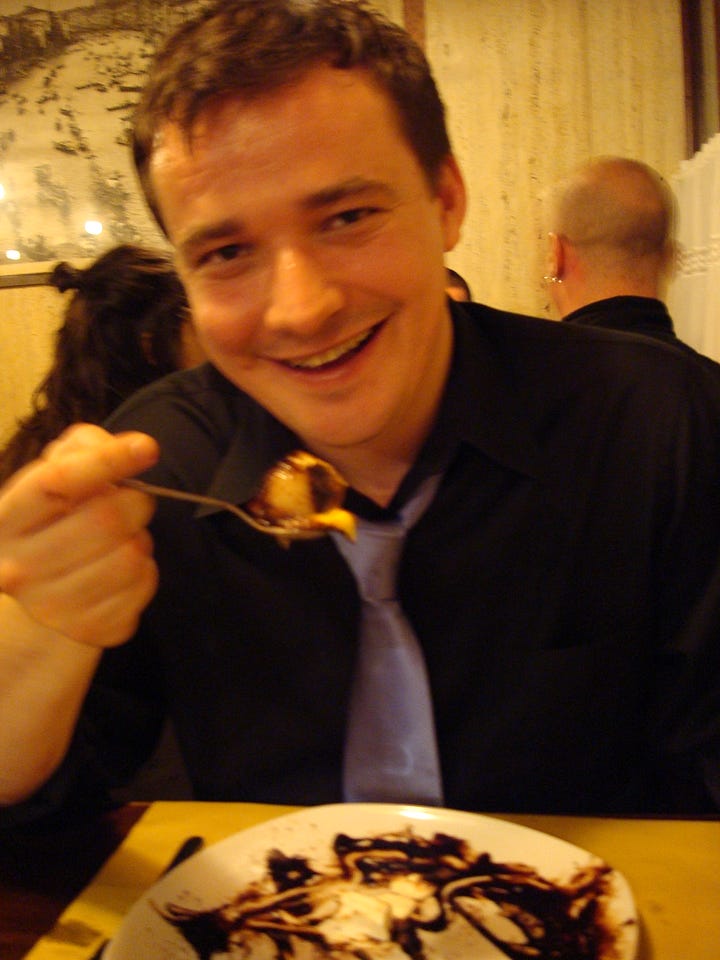

We loved our evening so much, we went back two nights later. Just as before, we got lost in search of the place, but eventually found our way. And we’ve been finding our way ever since. The menu always changes, but nowadays we have our favorites, one or more of which tend to recur on the menu when we visit. For starters, the schie con polenta are a Venetian staple: teeny tiny grey shrimp from the lagoon, fried and served over creamy polenta. If it’s there, the saltata di cozze are gorgeously fresh mussels sauteed in tomatoes, white wine, and tons of garlic, with parsley sprinkled on at the end to brighten the whole dish up. For primi, the linguine allo scoglio—linguine with shellfish—is a can’t miss, but if there is a stuffed pasta on the menu, we always get that, too. They are inevitably miraculous. And for secondi, Al Portego has the best frittura mista—mixed fried fish and seafood—that I’ve had. It’s perfectly salted and lightly crisped. A spectacular final course to any meal there.
When we got married in Venice a couple years after our first visit, the whole restaurant closed down to host a party for us—the first time they’d ever hosted a private event. Almost 100 of our friends and family populated the outside courtyard, wine in hand, as they awaited an open seat inside. Everyone took turns rotating through the handful of tables as Tibi and I gloried in the joy of our friends and family coming to know the magic of Al Portego. For me, there’s no satisfaction more profound than seeing people you love enjoy something to which you’ve introduced them. It’s a kind of warmth and joy I find myself chasing again and again.
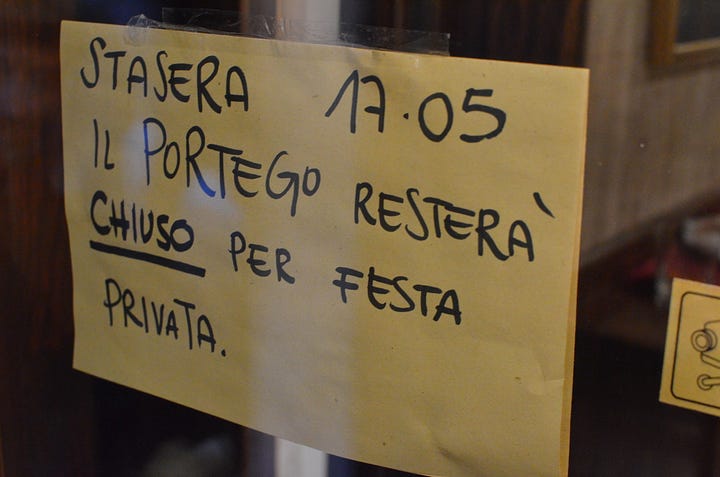
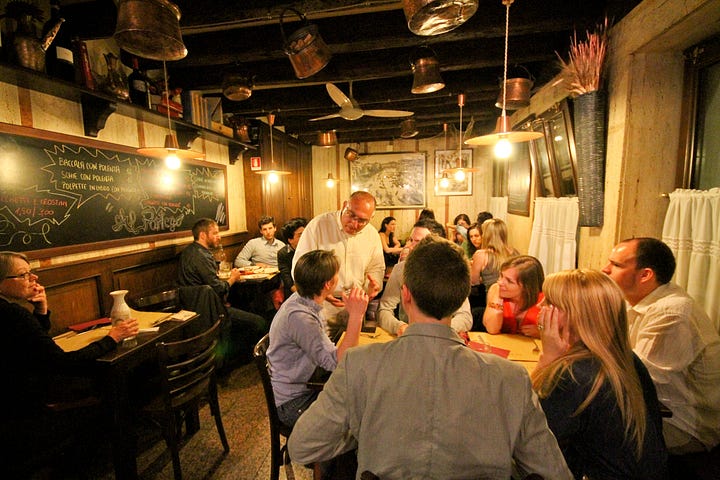
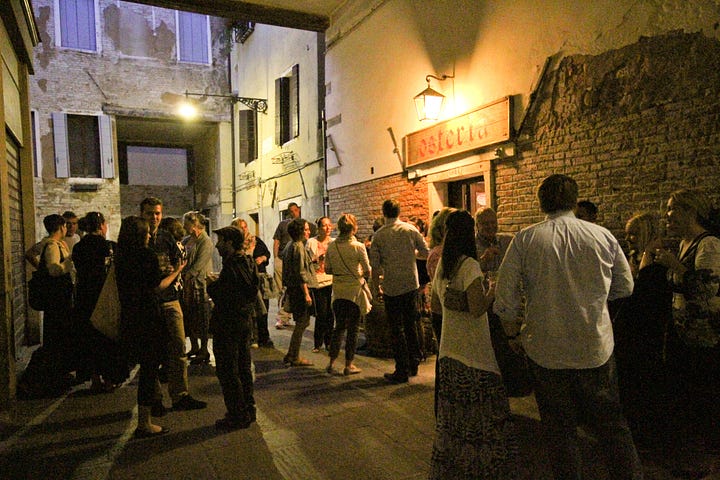
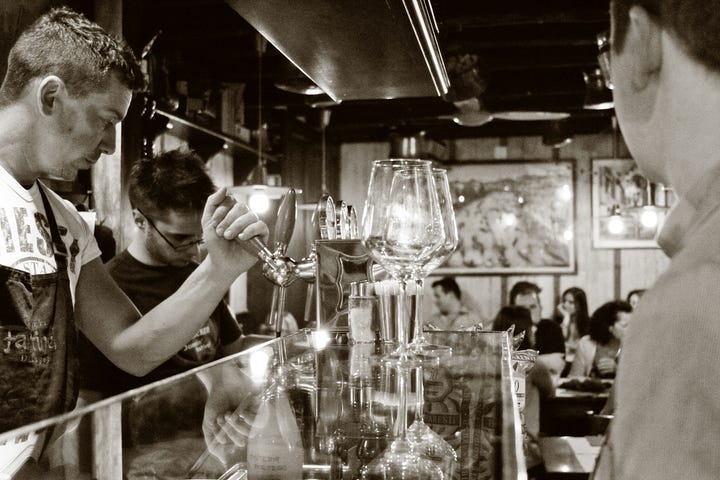
Today, whenever we go back to Al Portego, an old staff member will often introduce us to their newest colleague. I’m not sure they really know our names. We’re always just “i ragazzi”—“the boys.” But when we “boys” are introduced to the new chef or server, they will inevitably respond, “Oh! You’re the guys who had the party here!” In response, we smile and laugh, gleefully accepting the glasses of prosecco being passed our way, before sitting down to what is destined to be the best meal we’ve had in awhile.






Kerry, great work on your new Substack. I remember you and your family from Lawrencevill. My son Matt and I had a short tenure as Indian Guides with you and your father. You have definitely learned the skill (doesn’t seem like the right word) to savor a place and it’s people rather than checking it off on a life list. Keep sharing and hello to your parents.
Yo también tengo ganas de regresar a Venecia